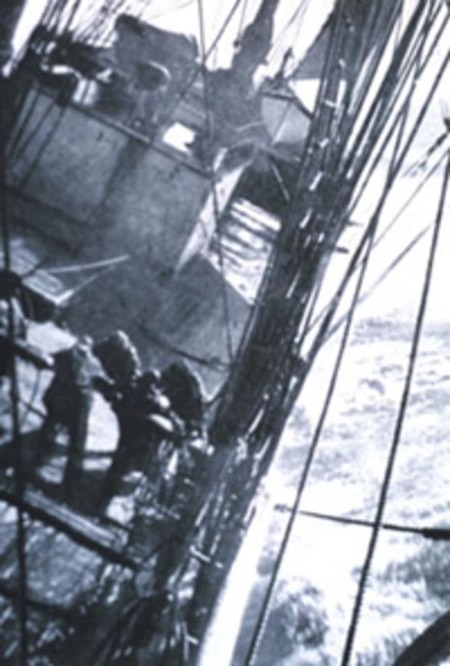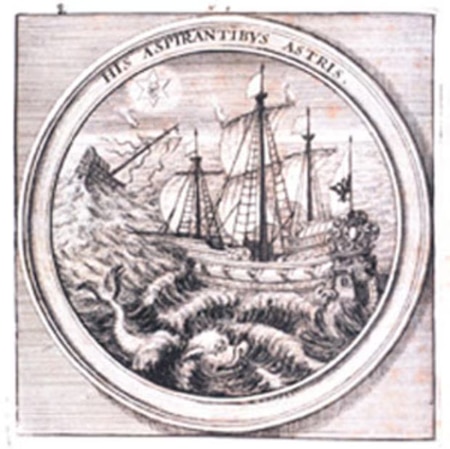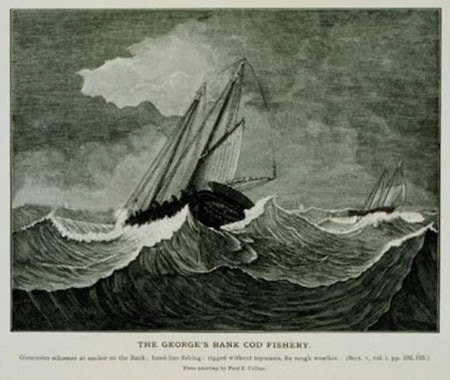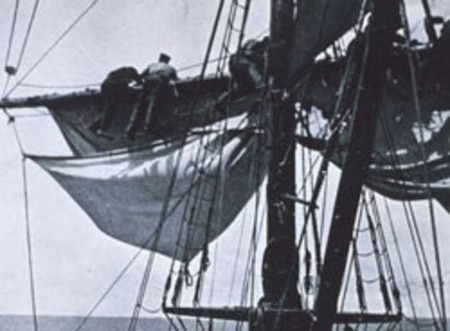Here in Massachusetts, we are quite familiar with the stories of witches, witchcraft, black magic, and spells—after all, our very own City of Salem was the site of the witchcraft trials of 1692-3. Less familiar, but as deeply intriguing, are some of the strange and spooky sea stories that took place on and off the coast of the Bay State. Back before the time of Global Positioning Systems (GPS) and NOAA nautical charts, the coast of Massachusetts was considered a perilous place for ships ferrying cargo, catching fish, or attempting to reach port. Craggy headlands, unseen shoals, strong currents, extreme tides, fierce nor'easters, and a few pirates led to the demise of many a ship and crew. Add to these perils the bloodshed from the Revolutionary and Civil Wars, the risk of succumbing to disease in the days before antibiotics, or the potential of a visit from a sea monster and you have set the stage for a rich history of hair-raising Massachusetts maritime folklore. Though the historical facts of the following "lucky seven" stories (and the apparitions themselves) may or may not necessarily be clear, everyone enjoys a good spine-tingling story. So sit back, read on, click the links for more information, or head on over to one of these mysterious coastal sites to see for yourself.
- The Lost Treasure of the Pirate Ship Whydah - The Whydah was launched in 1715 as a 100-foot, three-mast sailing ship that linked England, Africa, and the Caribbean in its "triangular trade" of slaves and goods. On her second voyage in 1717, the Whydah was overtaken near the Bahamas and claimed by pirate Sam Bellamy and his crew consisting of former slaves, displaced Englishmen, Native Americans, and social outcasts—a band bonded in their common goal to revolt against the King of England. With Bellamy now at the helm, the Whydah sailed north along the east coast of the "New World" and looted over 50 vessels, collecting at least 180 bags of gold and silver. Their luck ran out, however, when Bellamy chose to divert to Eastham on Cape Cod so that he could visit with his mistress. A nor'easter struck on April 26, 1717, and the ship was unable to head to deeper waters before being wrecked on a sandbar with her contents spilling hither and yon (on what is now Marconi Beach in Wellfleet). Only eight of the 146 crew members made it to the beach alive (and six of these were later hanged for their crimes), making the Whydah wreck the worst ever on the Cape in terms of casualties. In the days that followed, much of the booty itself was plundered by the locals (with a few pieces being returned to the crown), but an unknown quantity remains deep on the ocean floor. The search for the lost treasure continues today (the wreck was rediscovered in 1984, nearly 300 years later!). Selected artifacts from the wreck, such as cannons and firearms, are displayed at the Whydah Museum in Yarmouth and at the Expedition Whydah Museum in Provincetown. Here you can also learn more about how treasures are collected from the seafloor and how history is deciphered—including the fascinating story of this famous ship, her captain, and crew.
- The Haunted Plymouth Light - Plymouth (Gurnet) Light, located on a seven-mile long peninsula at the tip of Duxbury Beach known as the Gurnet, is America's oldest wooden lighthouse and the first lighthouse built with two towers. It is also believed to be visited by the ghost of the former lighthouse keeper, Hannah Thomas. John and Hannah Thomas became lighthouse keepers when the colonial legislature authorized the building of the station on their land in 1768. Soon after, John left to fight in the Revolutionary War and died of smallpox, leaving Hannah as America's first woman lighthouse keeper. Neighbors reported that they would see the grieving Hannah waiting by the window for her husband's return. Today, long after her death, some say that Hannah still keeps her vigil, making brief appearances at the window. Plymouth Light, owned by the U.S. Coast Guard and operated by Project Gurnet & Bug Lights, is currently situated 140 feet back from its original location (due to eroding bluffs). Now with only one light, it remains an active aid to navigation. A yearly open house allows visitors to explore the site, while the keeper's cottage built in 1962 can be rented for a spooky night's stay. For the history, see Plymouth Light - History in New England Lighthouses: A Virtual Guide.
- The Great New England Sea Serpent - Otherwise known as "His Snakeship," this most famed Massachusetts sea serpent was reported by hundreds of observers to have been cavorting around the waters of Cape Ann and Marblehead Harbor during the summers of 1817 and 1818. The descriptions of the creature (by people of credible nature) were common and consistent: "a strange marine animal, between eighty and ninety feet in length and about the size of a half barrel, heavy joints from his head to his tail, with something like the head of a rattlesnake, but nearly as large as the skull of a horse." The Linnaean Society of New England gave him a quasi-scientific name of Scoliophis atlanticus, or Atlantic humped snake, and he was widely accepted as the only true sea serpent in the world (Nessie, Champ, and Caddy hadn't been spotted yet). A playful sort of fella, he was not illusive or hard to find—reports indicated that this highly visible creature would swim around in circles, sun himself at the surface, feed on an abundance of herring, and generally mind his own business. Attempts to capture His Snakeship—dead or alive—were thwarted by his seemingly invincible nature, and he (or his offspring) continued to roam the Massachusetts Bay waters throughout the 1800s (such as reported in 1897 and 1899) and 1900s (reported in 1925 and 1997). Was this a real sea serpent? Could he still be out there? Read the lengthy details and first-hand accounts compiled by J.P. O'Neill in The Great New England Sea Serpent to decide for yourself.
- The Lady in Black at Fort Warren - George's Island in Boston Harbor is the site of historic Fort Warren, which is maintained by the Department of Conservation and Recreation (DCR) and home of the legend of the Lady in Black. Completed in 1850, the fort was built to protect the main shipping channels in the harbor. It was also used for training Union soldiers, and later as a prison for Confederate soldiers during the Civil War. One lieutenant soldier, who was incarcerated in the fort's "Corridor of Dungeons," was able to get a message to his new wife of his whereabouts. This bold woman found her way to the island and snuck into the dungeon (wearing men's clothing), only to be caught when trying to exit with her husband. In the kerfuffle that followed, she accidentally shot and killed her lieutenant husband. The grieving newlywed was then ordered to be hanged for treason. Distraught but still dignified, she requested woman's clothing for her execution. The closest thing available in the fort were some black robes, which she donned to face death. It is rumored that this Lady in Black returned to haunt the men stationed at the fort—with reports of footprints in the snow leading nowhere, stones rolling across storerooms, apparitions of the robed figure, and the sound of her voice. The fort continued to be active through World Wars I and II and was finally decommissioned in 1947. Now a National Historic Landmark, Fort Warren is open to the public for exploration with a park ranger or—if you dare—on a self-guided tour (see the Explore Georges Island web page on BostonHarborIslands.org for details). For more on the sad and strange story of the spirit that haunts the fort, see The Legend of the Ghost of the Lady in Black by Edward Rowe Snow.
- The Ghost Ship, Mary Celeste - In 1872, Captain Benjamin Briggs (a native of Marion, Massachusetts)—along with his wife, two-year-old daughter, and crew of seven—set sail across the Atlantic on the brigantine merchant ship Mary Celeste to deliver a cargo of 1,701 barrels of alcohol to Italy. About a month after their departure, a fellow merchant ship spotted the Mary Celeste off the coast of Portugal sailing haphazardly with her sails torn. What they found upon boarding was a seemingly seaworthy ship, good supplies of food and fresh water, the crew's personal possessions, but not a trace of a single person! Though there was no sign of foul play, the only lifeboat on the Mary Celeste was missing, a frayed line was trailing in the water behind the ship, and nine barrels of the alcohol were empty. The many speculations about the source of what happened to the Mary Celeste and her crew include sea spouts, sea monsters, pirates, and the Bermuda triangle, as well as the theory that the ship was simply cursed (since it had a long history of accidents, including the death of three captains). The most reasonable explanation, however, may be that after a small explosion of alcohol fumes in the main hatch, the crew jumped into the lifeboat with intentions of trailing behind the ship until the danger was over but were unable to keep the line secured and the Mary Celeste sailed off without them. The crew could have succumbed to hunger, thirst, and exposure while drifting in the life raft. Whatever their fate, it likely wasn't a good one. With no clear explanation, the Mary Celeste remains one of the most mysterious ghost ship stories around. Read about the details in Abandoned Ship: The Mary Celeste by Jess Blumberg on Smithsonian.com.
Something Scarier than a Spooky Abandoned Ship—Ghost Gear! - "Ghost gear"—discarded or lost fishing gear, such as nets, plastic lines, and lobster pots—causes many problems in the marine environment. It entangles and chokes sea life, damages fishing equipment and engines, and adds to the already overwhelming quantities of marine debris in the ocean. To find out more, see the Newburyport News article 'Ghost gear' finds a better place to haunt for information on efforts to collect and recycle derelict ghost gear in Newburyport, the Food and Agriculture Organization of the United Nations Abandonment of Fishing Gear web page for information on the ghost gear issue, and NOAA's Marine Debris Program website for details on the effects of marine debris on wildlife.
- The Phantom Fishermen on the Charles Haskell - The City of Gloucester is known as America's oldest fishing community—its protected and picturesque harbor and its close proximity to the productive fishing grounds of Georges Bank made it an ideal location for the early English settlers to launch a thriving fishing industry. With many generations of Gloucester fishermen (and women) going out to sea in search of cod, haddock, halibut, swordfish, and lobster, it was a way of life (and death) for these seafarers—and still is. The Fisherman's Memorial stands as a reminder of the thousands (perhaps up to 10,000!) of Gloucester fishermen who have been lost at sea. One particular story started in 1886, when a workman doing a final inspection for the maiden voyage of a cod-fishing schooner, the Charles Haskell, slipped and broke his neck. Superstitious locals immediately believed the boat to be cursed, but a captain by the name of Curtis set sail to Georges Bank anyway and found himself in the middle of a hurricane. The unfortunate Haskell and another even more unfortunate fishing vessel, the Andrew Johnson, collided, shearing the Johnson in half. While the Johnson and her entire crew sank to the bottom of the sea, the Haskell was able to weather the storm and head back to Gloucester for repairs. On her second voyage to Georges Bank, Haskell's captain and crew claimed to see the ghost fishermen of the Andrew Johnson as shadowy figures that emerged from the sea, climbed aboard, set to work, and then climbed back overboard at dawn. It is said that after that long, strange trip back to port, the Haskell sat in the harbor never to be touched by another fisherman again (it is thought that a Canadian captain finally bought her for purposes of transporting wood). To read more on this story of supernatural sailors from the sea, see Ghosts of the Charles Haskell in Weird Massachusetts by Jeff Bellanger.
- Shipwreck Spirits of the Jennie M. Carter - In April of 1894, the schooner Jennie M. Carter, which was sailing from Maine to New York and carrying a cargo of brick and granite, encountered a nor'easter, lost her bearings, and became shipwrecked on Salisbury Beach. During the storm, another schooner passed the Carter and claimed to have seen the struggling crew in the rigging, but they were unable to come about to assist due to lack of visibility and high seas. The six on board the Carter, including the captain and his niece, are alleged to have fled in lifeboats, but their fate remains a mystery (though two bodies ultimately washed up on shore, the lifeboat and the rest of the crew were never seen again; the only thing that survived was a cat who was left on board). Since the shipwreck, there have been numerous reports of mysterious activity on the beach and in the nearby buildings, such as strange lights, shadows, and late-night voices. If these potential spectral remains don't lure you to Salisbury Beach to see for yourself, the physical remains of the ship (which are still visible at dead low tide) may. In addition, historical pictures of the wreck can be seen at the Custom House Maritime Museum in the City of Newburyport. And for more on the spirits, see The Wreck of the Jennie M. Carter by Karen M. Mossey on ectoweb.com.
Other Shipwrecks to Explore Along the Bay State's Shore - The Massachusetts Board of Underwater Archaeological Resources, hosted by the Massachusetts Office of Coastal Zone Management (CZM), provides a list of approximately 40 shipwrecks that you are free to explore under water! See their Exempted Shipwreck Sites web page for the list of vessels fully open to recreational divers, with detailed descriptions of their fateful demise, the exact location of the shipwreck, and dive site conditions.
All photographs courtesy of National Oceanic and Atmospheric Administration/Department of Commerce Photo Library.



